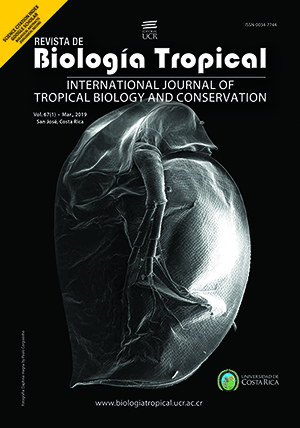Abstract
Spiders have managed to colonize most terrestrial environments, being common in forests. This group has been reported from the ground to the canopy and their vertical distribution patterns have been shown to be variable in different ecosystems. Taking into account this variability, the aim of this work was analyzed the changes in composition and diversity of weaver spiders in a vertical plane in two fragments of dry forest with different structural quality of vegetation. For this purpose, two sites were selected: Reserva Campesina La Montaña (RCM) and Corrales de San Luis (CSL). In each one, four samplings were carried out, two in the dry season and two during the rains. Per fragment, five stations spaced 100 m apart were selected and three points were marked 30 m apart where the plant strata were sampled as: low (20 cm - 2 m), medium (5 m - 8 m) and high (≥ 10 m). To capture the spiders, the foliage beating technique was used. 521 individuals grouped into nine families and 37 morphospecies were captured; RCM being the fragment with the greatest abundance and wealth (n = 335, 28 morphs). On the other hand, the low stratum presented the greatest diversity of the group, regardless of the time and the fragment. A vertical stratification pattern was observed for the community of weaver spiders during the rains period in the RCM, which disappeared in the dry season, whereas in CSL was not possible to observe this pattern in any of the seasons. The results indicate that the spider communities present in BST fragments are able to be vertically stratified, which depends on the time of year and the vegetation conditions in the study area.
##plugins.facebook.comentarios##

This work is licensed under a Creative Commons Attribution 4.0 International License.
Copyright (c) 2019 Luis Guillermo Quijano Cuervo, Jorge Rangel Acosta, Neis Martínez Hernández, Alexander Sabogal Gonzalez


